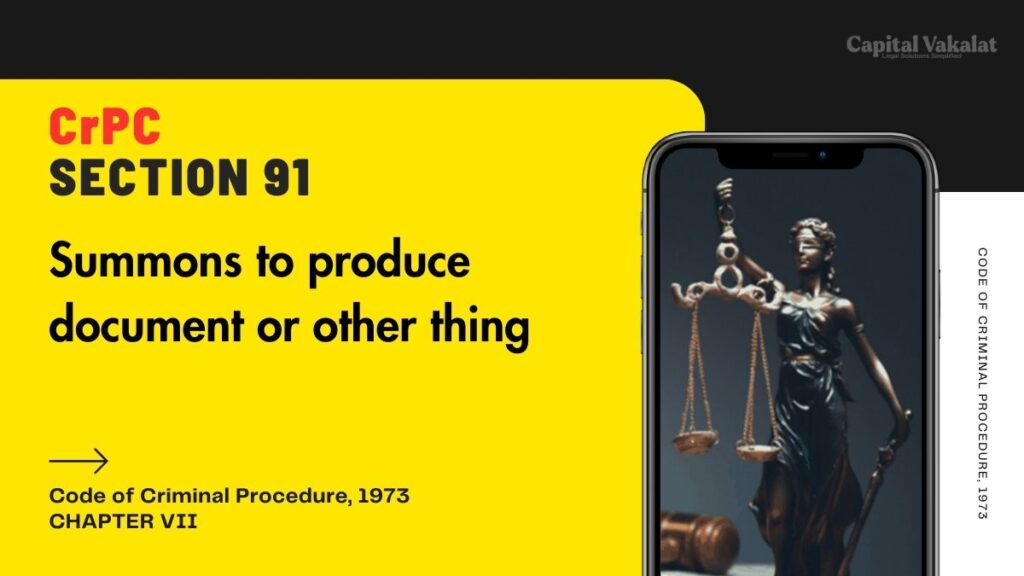Section 91 CrPC is a critical provision in the Indian legal system, enabling the court to summon the production of documents or other items essential to a case.

This article delves into the significance, application, and nuances of Section 91 of the Code of Criminal Procedure (CrPC), providing a comprehensive understanding for legal practitioners, students, and anyone interested in the intricacies of Indian law.
Bare Act. Section 91 Cr.P.C.
Summons to produce document or other thing.
(1) Whenever any Court or any officer in charge of a police station considers that the production of any document or other thing is necessary or desirable for the purposes of any investigation, inquiry, trial or other proceeding under this Code by or before such Court or officer, such Court may issue a summons, or such officer a written order, to the person in whose possession or power such document or thing is believed to be, requiring him to attend and produce it, or to produce it, at the time and place stated in the summons or order.
(2) Any person required under this section merely to produce a document or other thing shall be deemed to have complied with the requisition if he causes such document or thing to be produced instead of attending personally to produce the same.
(3) Nothing in this section shall be deemed--
(a) to affect sections 123 and 124 of the Indian Evidence Act, 1872 (1 of 1872), or the Bankers Books Evidence Act, 1891 (13 of 1891), or
(b) to apply to a letter, postcard, telegram or other document or any parcel or thing in the custody of the postal or telegraph authority.
Historical Context of Section 91 CrPC
The Code of Criminal Procedure (CrPC) was enacted in 1973, consolidating and amending laws related to criminal procedure in India. Section 91, in particular, is rooted in the necessity for fair trials, ensuring all pertinent evidence is available for judicial scrutiny. This section empowers courts to mandate the production of documents or other items deemed crucial for resolving legal disputes.
Purpose and Scope of Section 91 CrPC
Section 91 CrPC serves a dual purpose: it aids in the discovery of truth and ensures justice is served by allowing courts to access necessary evidence. This provision is not limited to documents alone but extends to any item relevant to the proceedings, thus broadening its applicability.
Mechanism of Issuing Summons under Section 91 CrPC
The procedure for issuing a summons under Section 91 CrPC is straightforward yet stringent, ensuring no misuse. The court must be convinced of the relevance and necessity of the document or item before issuing a summons. This mechanism safeguards against arbitrary or vexatious demands.
Judicial Interpretation of Section 91 CrPC
Over the years, the judiciary has interpreted Section 91 CrPC in various landmark cases, refining its application. Courts have emphasized the need for a balanced approach, ensuring the provision is not used for fishing expeditions but genuinely aids in justice.
Impact on Legal Proceedings
The impact of Section 91 CrPC on legal proceedings is profound. By compelling the production of evidence, it ensures that trials are conducted based on comprehensive facts, thereby enhancing the fairness and transparency of the judicial process.
Challenges and Controversies
Despite its importance, Section 91 CrPC has not been free from challenges and controversies. Critics argue that it can be misused to harass parties or delay proceedings. Balancing the need for evidence with protecting parties from undue hardship remains a judicial challenge.
Comparative Analysis with Other Jurisdictions
A comparative analysis reveals that similar provisions exist in other jurisdictions, each with unique nuances. For instance, the United States’ Federal Rules of Evidence have provisions for subpoenaing documents, offering insights into how different legal systems handle the production of evidence.
Section 91 CrPC in Practice: Case Studies
Examining case studies where Section 91 CrPC was invoked provides practical insights. These cases illustrate the real-world application, challenges faced, and judicial reasoning in summoning documents or other items.
Relevance in Modern Legal Practice
In today’s digital age, Section 91 CrPC remains relevant, though its application has evolved. The rise of electronic documents and data necessitates adapting traditional legal provisions to contemporary contexts.
Future Prospects and Reforms
Looking ahead, potential reforms to Section 91 CrPC could address existing challenges, ensuring its efficacy and fairness. Legal experts suggest amendments to refine its scope and application, aligning it with modern judicial needs.
Conclusion
Section 91 CrPC plays a pivotal role in the Indian legal system, ensuring that all necessary evidence is available for just and fair adjudication. Despite its challenges, it remains a cornerstone of legal proceedings, continually evolving to meet contemporary demands.
Frequently Asked Questions
When can Section 91 CrPC be invoked?
It can be invoked when the court deems a document or item crucial for determining the outcome of a case.
Can Section 91 CrPC be misused?
While there are safeguards, potential misuse exists, primarily through frivolous or vexatious demands for documents.
How does Section 91 CrPC compare to similar provisions in other countries?
Similar provisions exist globally, with each jurisdiction having unique mechanisms to summon evidence.
What are the future prospects for Section 91 CrPC?
Potential reforms could address current challenges, ensuring the provision remains effective and fair in modern contexts.
How has digitalization affected Section 91 CrPC?
Digitalization necessitates adapting Section 91 to include electronic documents and data, expanding its traditional scope.